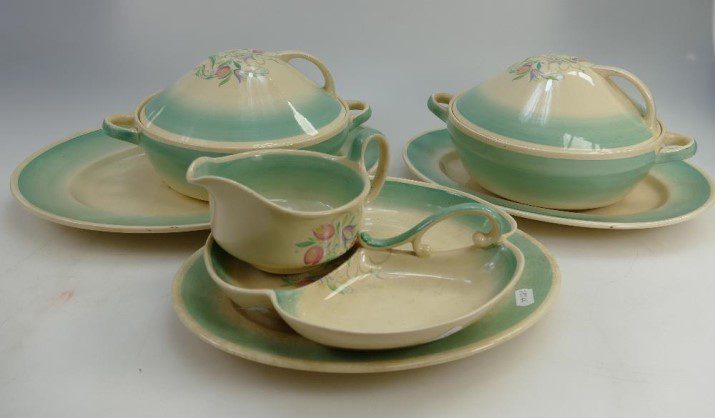
This delightful collection of Susie Cooper crown works, Burslem dinnerware (in the Dresden Spray design), comprising of tureen and covers, cups and saucers, sold in one of our Fine Art sales. It’s quality and design really is stunning.
Susie Cooper was a household name in the Potteries during the 1920s through to the 1980s, with her ceramics are still well-loved and collectable to this day.
At Potteries Auctions, we enjoy valuing and selling the locally produced and sought-after ceramics from centuries past, and Susie Cooper’s designs are no exception. As part of Susie’s career, you’ll find bright art deco pieces and fine bone china tea sets, mixed with distinctively shaped tea and coffee pots, all decorated with beautifully crafted designs – lithograph pictures, floral patterns or clean lines.
The choice of Susie Cooper ceramics is vast, and here at Potteries Auctions we can help you sell your pieces or curate a stunning collection.
Read our Susie Cooper pottery marking guide to find out more information about your ceramics or identify which pieces you should look out for.
The History of Susie Cooper the Ceramist
Like many of her contemporaries, Susie Cooper started drawing and developing an interest in art from a young age. After attending the Burslem School of Art, Susie didn’t have to travel far to find work. Growing up and living in the home of the Potteries, Staffordshire, Susie was able to work for many pottery firms over the course of her career, which included the fabulous Wedgwood pottery.
Often compared to Clarice Cliff, Susie Cooper’s designs have even been said to be favoured by The Queen Mother!
In 1950 Susie set up Susie Cooper China and created her famous shaped pieces, such as the Quail and Can shape. In 1979 Susie even received an OBE for her work in the arts.

Susie Cooper pottery can often be identified by its beautiful colours. This floral decorated cup and saucer set was a wonderful addition to our recent auction and will make the buyer very happy.
How to Identify Susie Cooper Pottery
As Susie Cooper’s career was so eclectic there are lots of variations of her work, so spotting her designs is down to knowing which backstamps are hers.
Backstamps and identifying marks vary depending on the pottery company Susie was working with at the time. From 1922 to 1929, Susie Cooper worked with A E Gray potteries. This means you may find very early Susie Cooper pieces with A E Gray markings. These often have a ship marking in varying designs and colours, as seen below.

Photo Credit: Susiecooper.net
In 1931, Susie moved to a new factory to develop her work. It was during this time that the most famous of her markings – the leaping deer – was created. If you spot this marking on any of her pottery pieces, it will give you a good guide as to the age of the piece.
You can see an example of the leaping deer backstamp below. This stamp might be found in black, pink, green or even blue, and it was often used from 1932 to 1964.

Photo Credit: SusieCooper.net
Over her career, Susie used even more backstamps to identify her designs. Let’s explore more of the stamps you should look out for.
Susie Cooper Backstamps
The first mark to look out for is an extremely rare mark. It was only used for a very short time. Often called the ‘Tunstall Triangle’, the mark was used in 1929.

The following stamp was used more frequently from 1930 to 1932. You may find it used with or without a triangle.

Further to this stamp, Susie used lots of triangle-shaped stamps as part of her markings, like the one below.

From 1933 to 1934, Susie added pattern numbers to certain pieces. The example below shows the wedding band pattern markings on a Kestrel shaped coffee saucer and cup.

On smaller pieces made from 1932 to 1964, you may find text only markings. Sometimes these will show the patter number too.

Another marking to look out for is the hand painted signature marking. This was often used from 1930 to 1980. Unfortunately, the hand painted nature of the signature doesn’t guarantee it was Susie Cooper who had painted the signature.

Photo Credit: SusieCooper.net
Later in her career, as Susie sold her pottery works to Wedgwood, a new backstamp was created. There are, of course, various versions of this backstamp, but spotting a piece with Susie’s name on a Wedgwood piece will give you a good indication of its age.

Photo Credit: The Old Stuff
Do you recognise any of these markings on your pieces? If you need further support, Potteries Auctions can step in. We can help you identify the date and rarity of your Susie Cooper pieces.

This is a wonderful example of a Susie Cooper set we have recently sold at auction.
How Much are My Susie Cooper Ceramics Worth?
Susie Cooper ceramics are quite unusual due to the wide-ranging value between each of the pieces. Some art deco collectable ceramics might fetch considerable amounts, whereas a fine china tea set might be more of an enjoyable investment for everyday use.
At Potteries Auctions, we can identify and provide valuations on a wide range of Susie Cooper pieces. Our team can help value your collection, turn you into a collector or advise on how much your Susie Cooper pottery could be worth.
Please get in touch with us to discuss how we can help you or request a call back if you are looking for an expert evaluation and are seeking to sell your Susie Cooper pottery. Alternatively, you can join us at one of our valuation days, email us for an appointment enquiries@potteriesauctions.com or call us on +44 (0)1782 638100 Monday to Friday, 9am to 4pm.
